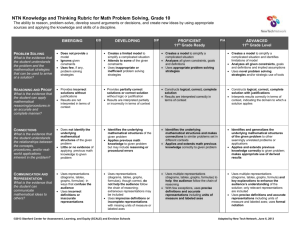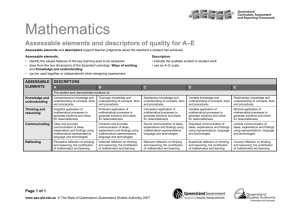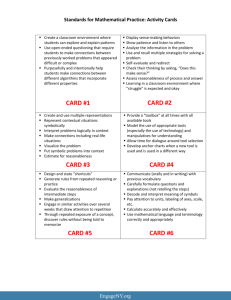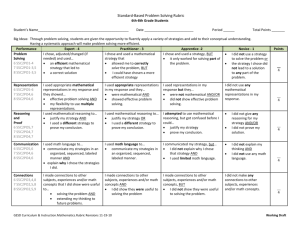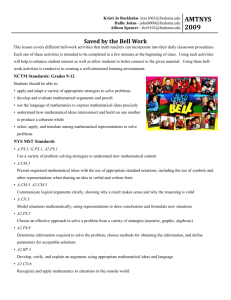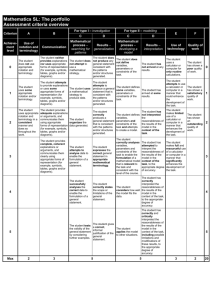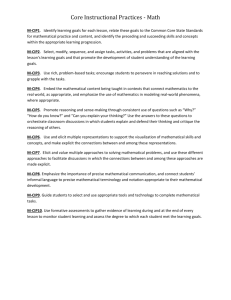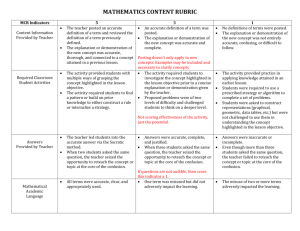Math - Problem Solving
advertisement
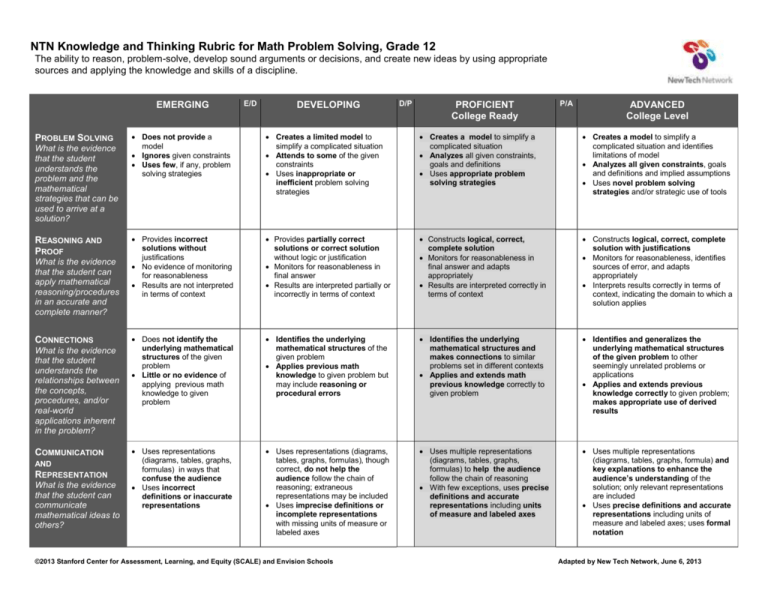
NTN Knowledge and Thinking Rubric for Math Problem Solving, Grade 12 The ability to reason, problem-solve, develop sound arguments or decisions, and create new ideas by using appropriate sources and applying the knowledge and skills of a discipline. EMERGING PROBLEM SOLVING What is the evidence that the student understands the problem and the mathematical strategies that can be used to arrive at a solution? REASONING AND PROOF What is the evidence that the student can apply mathematical reasoning/procedures in an accurate and complete manner? CONNECTIONS What is the evidence that the student understands the relationships between the concepts, procedures, and/or real-world applications inherent in the problem? COMMUNICATION AND REPRESENTATION What is the evidence that the student can communicate mathematical ideas to others? E/D DEVELOPING D/P PROFICIENT College Ready P/A ADVANCED College Level Does not provide a model Ignores given constraints Uses few, if any, problem solving strategies Creates a limited model to simplify a complicated situation Attends to some of the given constraints Uses inappropriate or inefficient problem solving strategies Creates a model to simplify a complicated situation Analyzes all given constraints, goals and definitions Uses appropriate problem solving strategies Creates a model to simplify a complicated situation and identifies limitations of model Analyzes all given constraints, goals and definitions and implied assumptions Uses novel problem solving strategies and/or strategic use of tools Provides incorrect solutions without justifications No evidence of monitoring for reasonableness Results are not interpreted in terms of context Provides partially correct solutions or correct solution without logic or justification Monitors for reasonableness in final answer Results are interpreted partially or incorrectly in terms of context Constructs logical, correct, complete solution Monitors for reasonableness in final answer and adapts appropriately Results are interpreted correctly in terms of context Constructs logical, correct, complete solution with justifications Monitors for reasonableness, identifies sources of error, and adapts appropriately Interprets results correctly in terms of context, indicating the domain to which a solution applies Does not identify the underlying mathematical structures of the given problem Little or no evidence of applying previous math knowledge to given problem Identifies the underlying mathematical structures of the given problem Applies previous math knowledge to given problem but may include reasoning or procedural errors Identifies the underlying mathematical structures and makes connections to similar problems set in different contexts Applies and extends math previous knowledge correctly to given problem Identifies and generalizes the underlying mathematical structures of the given problem to other seemingly unrelated problems or applications Applies and extends previous knowledge correctly to given problem; makes appropriate use of derived results Uses representations (diagrams, tables, graphs, formulas) in ways that confuse the audience Uses incorrect definitions or inaccurate representations Uses representations (diagrams, tables, graphs, formulas), though correct, do not help the audience follow the chain of reasoning; extraneous representations may be included Uses imprecise definitions or incomplete representations with missing units of measure or labeled axes Uses multiple representations (diagrams, tables, graphs, formulas) to help the audience follow the chain of reasoning With few exceptions, uses precise definitions and accurate representations including units of measure and labeled axes Uses multiple representations (diagrams, tables, graphs, formula) and key explanations to enhance the audience’s understanding of the solution; only relevant representations are included Uses precise definitions and accurate representations including units of measure and labeled axes; uses formal notation ©2013 Stanford Center for Assessment, Learning, and Equity (SCALE) and Envision Schools Adapted by New Tech Network, June 6, 2013
